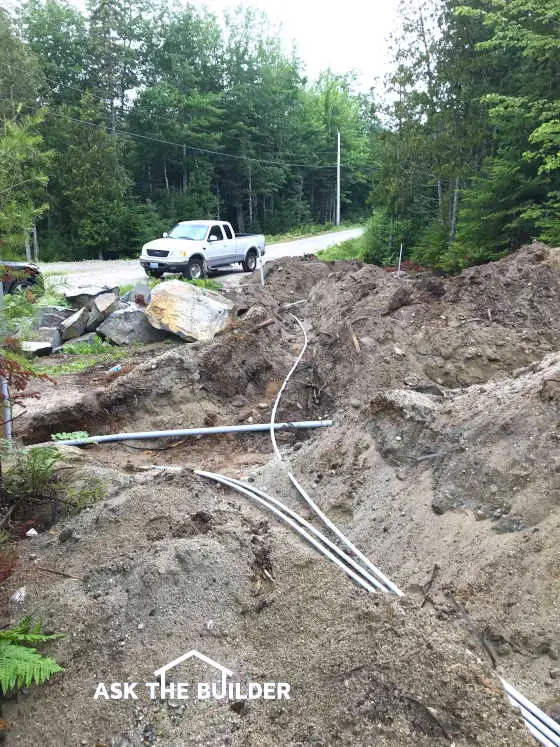Prevent Cut Electric & Cable Lines and Roofing Nails

Those gray plastic pipes in the trenches will soon have electric and cable-TV cables in them. The pipes help prevent future cut lines. The photo should be saved and taped to the electric panel cover! (C) Copyright 2020 Tim Carter
Prevent Cut Electric & Cable Lines
QUESTION #1: Tim, what are your thoughts on burying electric and cable-TV lines? I can buy approved cable and wire that’s rated for direct burial saving the cost of installing it in conduit. What’s been your experience with underground utilities like this? What would you do and why? Glenn A., Columbia, SC
Glenn’s questions are excellent. You may wonder the same thing if you’re building a new home or you might have a remodeling project planned at your home. Heck, it could be just a simple project of adding a new post lamp out on your back patio.
I didn’t build the home I currently live in. It has lots of underground buried cable. Just this past spring, all of a sudden one of my circuit breakers started tripping indicating a dead short. Had I been testing the electric monitoring system I’m now using, I would have been alerted to the dangerous arcing weeks before the breaker started tripping. But that’s a story for another day.
I traced the cause of the dead short to a small place where a buried cable passed through a plastic conduit that was installed under my driveway. The cable was rated for direct burial, but the annual frost heave in the soil here in New Hampshire had caused the cable to rub on the sharp cut edge at the end of the conduit. Eventually the up and down movement severed the insulation and the bare wires shorted out in the soil.
Had the cable been buried in conduit all the way from the house up to the post lamp at the end of my drive, I would not have had to waste a day replacing the cable and installing 70 feet of new conduit. I was shaking my head the entire time digging the new trench thinking, “How could the electrician or builder think saving $30 was a good idea?” That’s all the conduit would have cost when the house was built.
I’m a huge fan of putting all underground cables and wires inside conduit. I’m an even bigger fan of putting these in trenches deeper than the National Electrical Code minimum depth. Take this one step further, I’m a monster fan of taking photos of the open trenches after the conduit is installed and visible. Shoot photos from many angles showing future homeowners where the conduits and cables are buried. I print out these photos, put them in a waterproof plastic bag and tape the bag to the electric panel for safekeeping.
If you’re not a fan of using conduit, you may change your mind when that gardener in your family pierces a buried cable while digging a hole for that new bush or tree. With that in mind, it’s a really good idea to think about where landscaping might be in your yard. You may want to route underground cables and wires away from these digging zones of death. I’ve seen aggressive diggers cut through conduit thinking they were chopping a rock or a root.
Roofing Nails
QUESTION #2: It’s time for a new roof on my house. I’m going to install asphalt shingles. I decided to read the installation instructions before talking with roofers. Galvanized roofing nails are required. Are there different types of galvanized nails and is one better than the other? Is there anything I can do to make sure this is the last asphalt shingle roof I install? Maria P., Kalamazoo, MI
There’s a really good chance you might be in Maria’s shoes soon as more homeowners like you are replacing their asphalt roofs faster than they should have to. I was one myself as my own asphalt shingle roof that was supposed to last 30 years started to fail in just nine years or so.
I was so upset at this I wrote a book about why asphalt shingles disintegrated much faster than the shingles I used to install decades ago. My book, Roofing Ripoff, is an easy read and not one shingle manufacturer disputes the claims in the book. That tells you right away that what I say in the book is truth. But I digress.

Here's my Roofing Ripoff book. It's an easy one-hour read. You'll save $5,000 reading it. GUARANTEED. CLICK or TAP HERE to read the first three chapters for free.
There are big differences in galvanized nails. The best ones are hot-dipped galvanized nails. Better yet are ones that are double dipped. In this process, regular steel roofing nails are dropped into a vat of molten zinc. The nails are immediately heated up by the searing molten zinc and this creates a steel/zinc alloy. The zinc coating is relatively thick and it protects the nails from rusting.
The other methods of galvanizing nails are mechanical and chemical. These two methods also attach zinc to the steel nail, but the coating can be quite thin. Chemical galvanizing happens when the steel nails are put into a vat containing a zinc-based chemical solution. Electricity is sent into the vat and the zinc is pulled out of the solution and bonds to the steel nails.
Mechanical galvanizing happens when steel nails are tumbled in a large drum with zinc dust, glass beads, and a chemical. The zinc dust is hammered onto the steel nails. My own asphalt shingle roof had nails that had one of these two galvanizing processes and many of them had rusted after just ten years.
When I was doing research for my Roofing Ripoff book, I was the first person in the world to discover that copper ions bond with sun-damaged asphalt molecules. When the copper locks onto the asphalt the asphalt molecules are unable to bond to nearby ones. This keeps the asphalt supple for many many years preventing the shingles from curling and losing ceramic granules.
I recommend applying a thin 12-inch-wide copper strip up at the top of the roof that’s blind nailed on new roof installations. The ultraviolet rays of the sun split off copper ions and these are washed down the roof with each rainfall where they grab onto the asphalt. Install this affordable thin copper rolls on each side of your roof and it’s quite possible your new asphalt shingles can last forty, or more, years like they used to. Check out my Roofing Ripoff book for photos and more details.
Column 1340